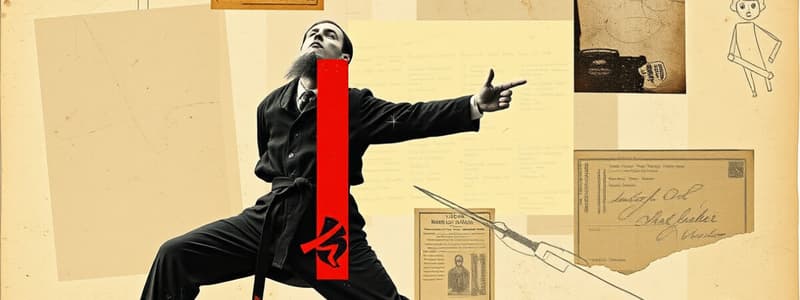Podcast
Questions and Answers
What is the primary goal of the recovery technique from a ground encounter?
What is the primary goal of the recovery technique from a ground encounter?
- To gain time and distance between you and the aggressive subject (correct)
- To engage more effectively with an aggressive subject
- To immobilize the aggressive subject immediately
- To practice verbal commands with clarity
Which action is NOT recommended when recovering to a standing position?
Which action is NOT recommended when recovering to a standing position?
- Ignoring the distance between you and the subject (correct)
- Using loud, clear verbal commands
- Maintaining an appropriate stance after standing
- Establishing a strong base before standing
During a hip escape, what should you do with your chin?
During a hip escape, what should you do with your chin?
- Lift it high to maintain visibility
- Tuck it to the chest to protect your neck (correct)
- Turn it to the side for better movement
- Rest it on the ground for stability
What is the main purpose of the hip escape technique?
What is the main purpose of the hip escape technique?
What is a key component in executing the hip escape correctly?
What is a key component in executing the hip escape correctly?
Which of the following is essential to do when applying the recovery technique?
Which of the following is essential to do when applying the recovery technique?
After recovering to the standing position, what should be your next step?
After recovering to the standing position, what should be your next step?
What movement technique is also referred to as shrimping?
What movement technique is also referred to as shrimping?
What does relative positioning refer to in the context of approaching a subject?
What does relative positioning refer to in the context of approaching a subject?
What is the recommended reactionary gap when you can see the subject's hands?
What is the recommended reactionary gap when you can see the subject's hands?
Which area is described as the danger zone?
Which area is described as the danger zone?
Which technique is NOT recommended when approaching a subject?
Which technique is NOT recommended when approaching a subject?
What is the first step to conduct a strip/unclothed search?
What is the first step to conduct a strip/unclothed search?
Which parts of the body should be visually checked during a strip search?
Which parts of the body should be visually checked during a strip search?
What should you avoid when in the danger zone?
What should you avoid when in the danger zone?
What must be done with bandages or casts during a search?
What must be done with bandages or casts during a search?
What does visual control of the hands allow an officer to do?
What does visual control of the hands allow an officer to do?
How should an officer identify themselves when appropriate?
How should an officer identify themselves when appropriate?
Who is authorized to perform body cavity searches?
Who is authorized to perform body cavity searches?
What is the primary purpose of blocks in defensive tactics?
What is the primary purpose of blocks in defensive tactics?
What is the most critical factor when assessing the approach to a subject?
What is the most critical factor when assessing the approach to a subject?
Which area does the upper area block protect?
Which area does the upper area block protect?
What is one technique that can be used after executing an upper area block?
What is one technique that can be used after executing an upper area block?
Which area is protected by the mid area block?
Which area is protected by the mid area block?
What should be done when a subject exhibits unusual symptoms during a confrontation?
What should be done when a subject exhibits unusual symptoms during a confrontation?
Which of the following is NOT a potential environmental factor to consider in threat assessment?
Which of the following is NOT a potential environmental factor to consider in threat assessment?
What is the proper alignment of the body in the interview stance?
What is the proper alignment of the body in the interview stance?
When assuming an offensive ready stance, where should your hands be positioned?
When assuming an offensive ready stance, where should your hands be positioned?
What is a key consideration for maintaining a subject's safety while restrained?
What is a key consideration for maintaining a subject's safety while restrained?
Which of the following describes the ideal knee position in the interview stance?
Which of the following describes the ideal knee position in the interview stance?
In the offensive ready stance, how should your feet be positioned?
In the offensive ready stance, how should your feet be positioned?
What should you do if a subject is displaying signs of post-traumatic stress disorder?
What should you do if a subject is displaying signs of post-traumatic stress disorder?
What does the totality of circumstances test primarily assess?
What does the totality of circumstances test primarily assess?
Which of the following is NOT considered in the totality of circumstances?
Which of the following is NOT considered in the totality of circumstances?
When determining if a use of force decision was legally justified, what is considered?
When determining if a use of force decision was legally justified, what is considered?
Which situational factor could increase the perceived threat during an encounter?
Which situational factor could increase the perceived threat during an encounter?
How does the concept of the totality of circumstances relate to defensive tactics?
How does the concept of the totality of circumstances relate to defensive tactics?
What may affect the duration of a confrontation according to the totality of circumstances?
What may affect the duration of a confrontation according to the totality of circumstances?
Why are environmental factors important in assessing totality of circumstances?
Why are environmental factors important in assessing totality of circumstances?
Which of the following factors relates to the officer's capabilities when assessing totality of circumstances?
Which of the following factors relates to the officer's capabilities when assessing totality of circumstances?
Flashcards are hidden until you start studying
Study Notes
Recover to the Standing Position
- Essential for safely getting up from ground encounters and avoiding strikes from aggressive subjects.
- Use loud verbal commands to communicate clearly during the technique.
- Establish a strong base when standing up, ensuring to protect vital areas.
- Maintain an appropriate stance for balance and readiness to react.
Hip Escapes (Shrimping)
- Useful for avoiding or defending against attacks, especially from positions like side control or full mount.
- Protect the neck and back of the head by tucking the chin during the escape.
- Push off with one foot, elevate hips, and move out toward the opposite side while using hands to create distance.
Totality of Circumstances
- A legal test analyzing overall facts to determine authority for detaining or searching individuals.
- Courts assess the reasonableness of an officer's force decisions based on perceived circumstances.
- Important factors include crime severity, immediate threat level, subject's history, officer's condition, and environmental factors.
Situational Factors
- Consider various situational elements impacting use of force decisions:
- Severity and nature of the crime.
- The potential danger posed by the subject.
- The subject’s known mental or violent history.
- The context of the confrontation, such as number of subjects versus officers and physical conditions.
Threat Assessment
- Recognize verbal and non-verbal cues indicating physical or mental health issues.
- Maintain a position ensuring open airways and proper circulation for restrained individuals.
- Request medical assistance when unusual symptoms are presented.
Environmental Factors
- Evaluate potential influences on threat assessment including:
- Weather, terrain, and presence of bystanders.
- Traffic conditions and nearby animals or weapons.
Stances
- Interview Stance: Feet shoulder-width apart, slight knee bend, body angled away from potential threats, hands positioned above the waist.
- Offensive Ready Stance: Feet slightly wider than shoulder-width, knees bent, strong side away from the subject, hands at eye level.
Relative Positioning
- Positioning is crucial when approaching subjects for safety.
- Maintain appropriate distance based on threat assessment.
Reactionary Gap
- Keep a distance of 6-9 feet when you can see the subject’s hands, or 25 feet when hands are obscured.
- The danger zone is defined by this gap; quick actions may be needed when entering this area while maintaining balance.
Visual Control of Hands
- Maintain visual awareness of subjects' hands to assess potential threats.
- Implement hand-clearing techniques to ensure safety when approaching.
Conducting Searches
- Strip/Unclothed Search: Instruct the subject clearly, conduct thorough checks on all body parts and personal items.
- Body Cavity Search: Permitted only by qualified health services per agency protocol.
Blocks and Strikes
- Blocks: Essential techniques for deflecting strikes using arms, legs, or body to protect against incoming attacks.
- Upper Area Block: Protects from the neckline to the head; can transition to counterstrikes.
- Mid Area Block: Shields torso and face, mitigating impact from strikes effectively.
Studying That Suits You
Use AI to generate personalized quizzes and flashcards to suit your learning preferences.




